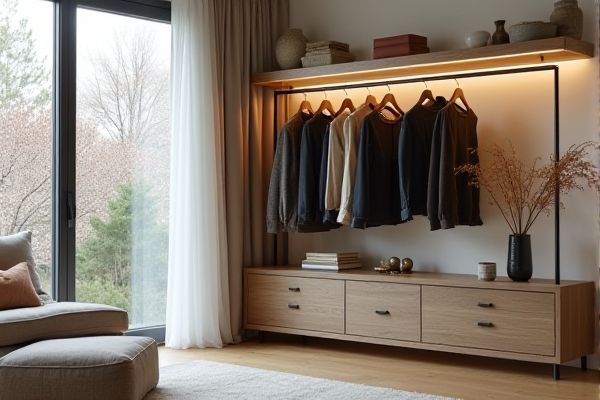
A garment rack offers mobility and versatile storage options, making it ideal for temporary or additional closet space, while a hanging bar provides a fixed, space-saving solution built into your room's structure for permanent organization. Explore the rest of the article to determine which option best suits your wardrobe needs and space.
Table of Comparison
| Feature | Garment Rack | Hanging Bar |
|---|---|---|
| Purpose | Portable storage for clothes | Fixed support for hanging garments |
| Mobility | Easy to move and reposition | Stationary, installed in closets or walls |
| Capacity | Varies; usually holds multiple garments (15-30 items) | Depends on installation; supports many garments |
| Installation | No installation required; ready to use | Requires mounting hardware and tools |
| Durability | Usually lightweight metal or plastic, less sturdy | Typically metal or wood, more durable and stable |
| Space Efficiency | Compact size but occupies floor space | Utilizes vertical space, saves floor area |
| Cost | Generally affordable and budget-friendly | Varies; often higher cost due to installation |
| Best Use | Temporary or flexible clothing storage | Permanent wardrobe or closet organization |
Introduction: Garment Rack vs Hanging Bar
Garment racks offer a portable and versatile solution for organizing clothing, featuring multiple bars or shelves for easy access and display. Hanging bars, commonly installed in closets, provide a fixed and streamlined option for hanging clothes in a compact space. Both options improve wardrobe organization but differ in mobility and capacity based on user needs.
Key Differences Between Garment Racks and Hanging Bars
Garment racks offer mobile, freestanding storage solutions with multiple bars or shelves for organizing a variety of clothing types, while hanging bars are fixed installations primarily designed to maximize closet space for hanging garments. Garment racks provide flexibility for easy repositioning and seasonal wardrobe changes, whereas hanging bars optimize vertical space but require permanent placement. Understanding these distinctions helps you choose the best solution for your storage needs and space constraints.
Design and Structure Comparison
Garment racks typically feature a freestanding frame with multiple bars and often include shelves or wheels, offering versatile storage and easy mobility. Hanging bars are usually fixed or wall-mounted, designed for a streamlined, space-saving approach ideal for displaying a limited number of clothes. Your choice depends on whether you prioritize flexibility and capacity or a minimalist, stationary solution in your room's layout.
Space Efficiency: Which Saves More Room?
Garment racks maximize space by combining storage and mobility, featuring multiple tiers for clothes, shoes, and accessories, making them ideal for compact areas. Hanging bars offer a streamlined solution primarily for hanging clothes, occupying less floor space but limiting storage options beyond garments. Choosing your best option depends on whether you prioritize versatility and storage capacity with a garment rack or minimal footprint with a hanging bar.
Installation and Setup: Ease of Use
Garment racks offer straightforward installation with minimal assembly, often requiring only simple tools or none at all, making them ideal for quick setup. Hanging bars typically demand wall mounting or ceiling installation, which may involve drilling and more complex tools, affecting ease of use. Choosing a garment rack allows you to instantly organize clothes without permanent fixtures, enhancing convenience and flexibility.
Durability and Weight Capacity
Garment racks often feature sturdy frames made from steel or heavy-duty aluminum, providing superior durability and higher weight capacity compared to typical hanging bars, which are commonly constructed from lighter materials such as plastic or thin metal. The reinforced joints and thicker tubing of garment racks allow them to support larger loads, making them ideal for storing multiple heavy coats or bulky apparel without bending or breaking. In contrast, hanging bars may be more prone to warping under substantial weight, limiting their use to fewer or lighter garments.
Versatility and Storage Options
Garment racks offer enhanced versatility with multiple levels and adjustable shelves, allowing for diverse storage options such as hanging clothes, stacking shoes, and organizing accessories. Hanging bars typically provide a single horizontal rod designed primarily for hanging garments, limiting storage to items that can be hung. For maximizing space and accommodating various storage needs, garment racks are a more flexible choice compared to the singular hanging bar approach.
Aesthetic Appeal and Home Décor Impact
Garment racks offer an industrial-chic aesthetic that enhances modern or minimalist home decor, creating an open and airy visual appeal. Hanging bars, often built into closets or walls, provide a sleek and seamless look that integrates effortlessly with your existing room design. Your choice between the two influences how clothing displays complement or contrast with the overall aesthetic of your living space.
Price Comparison: Budget Considerations
Garment racks typically offer a more affordable option compared to hanging bars, making them ideal for those working within a tight budget. Their portable, freestanding design reduces installation costs, while hanging bars often require professional fitting or wall modifications that increase overall expense. You can optimize your wardrobe setup cost-effectively by choosing a garment rack if upfront price preferences are a priority.
Choosing the Best Option for Your Needs
A garment rack offers portability and versatility, ideal for those who need a flexible storage solution for seasonal clothing or display purposes. Hanging bars, often fixed in closets, provide a sturdy, space-saving option for organized daily wear, supporting heavier items like coats or suits. Evaluating your space constraints and clothing volume will help you choose the best option for your needs.
 homyna.com
homyna.com